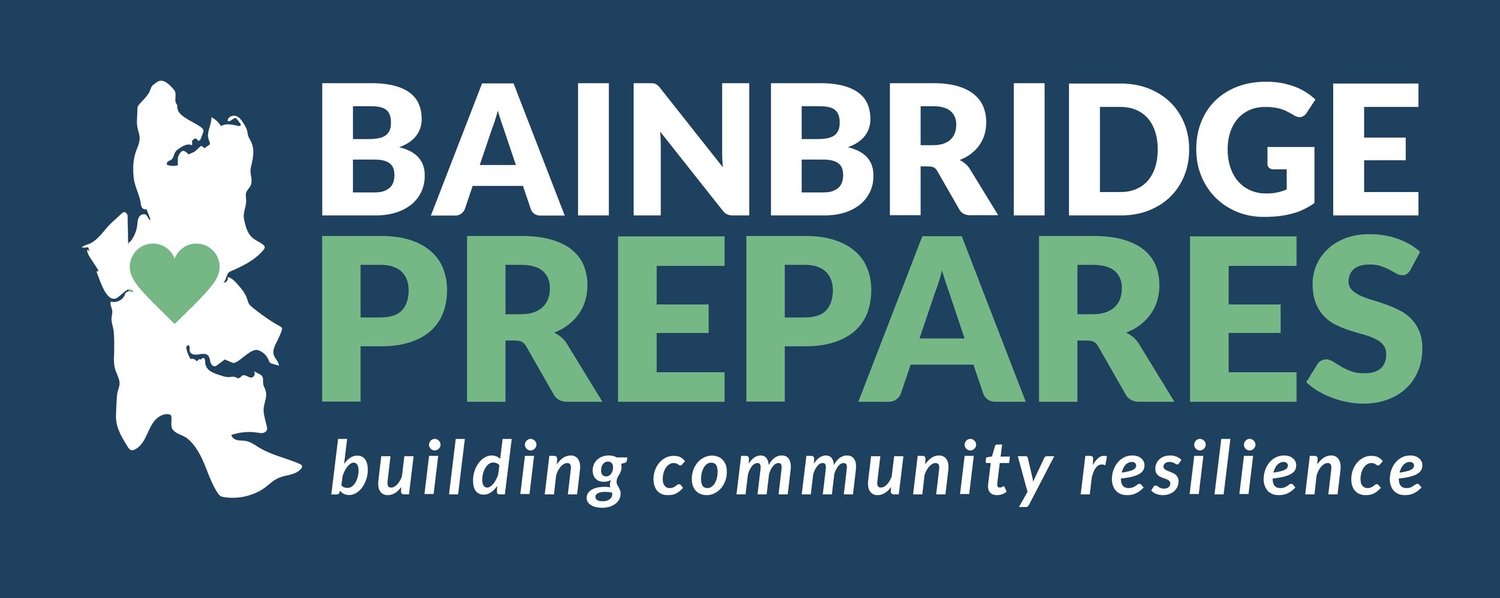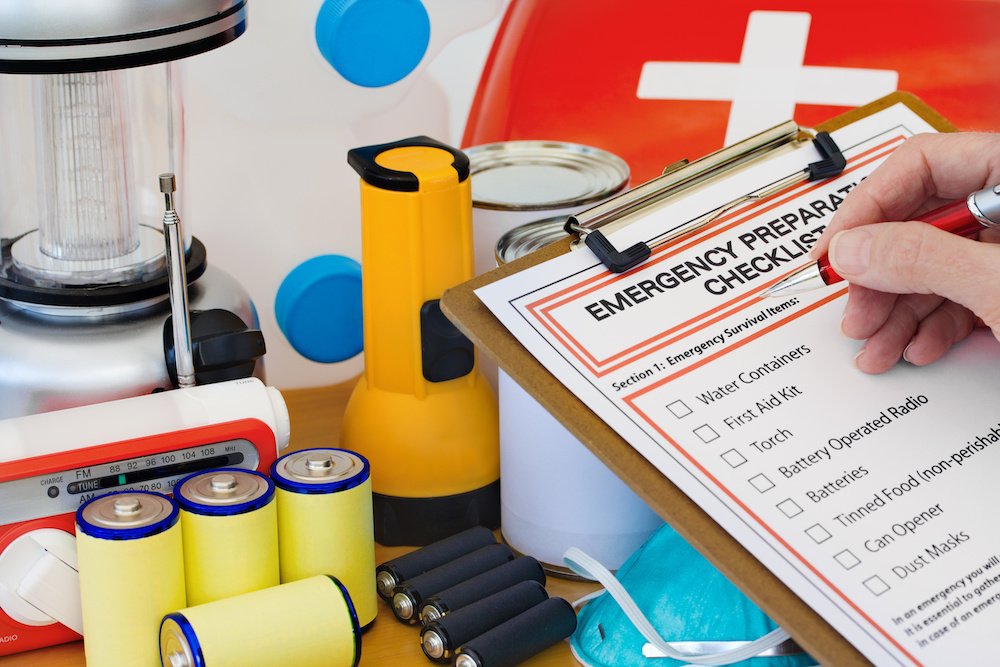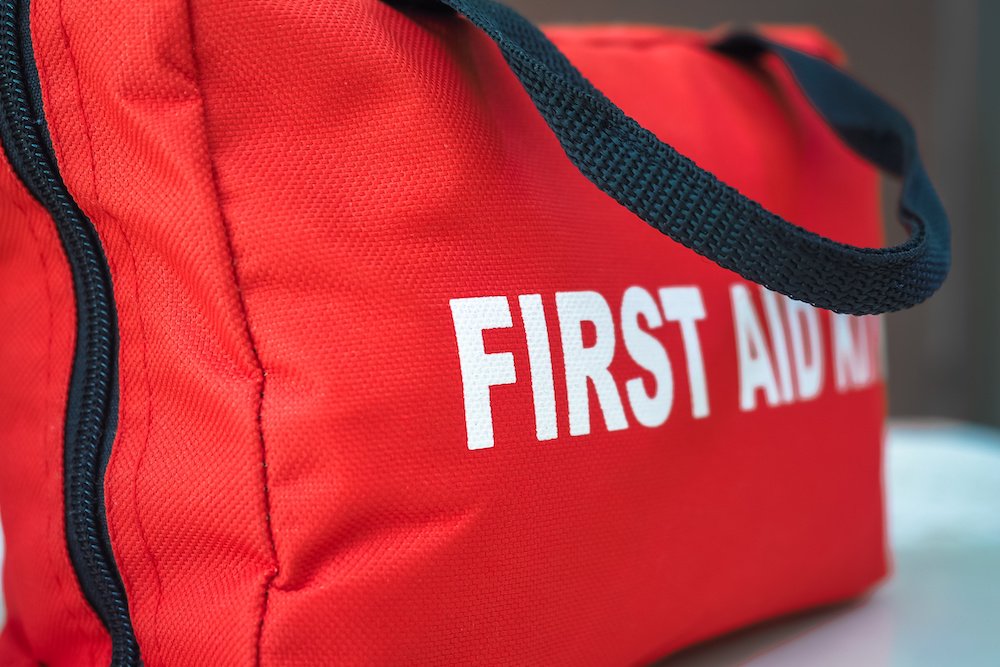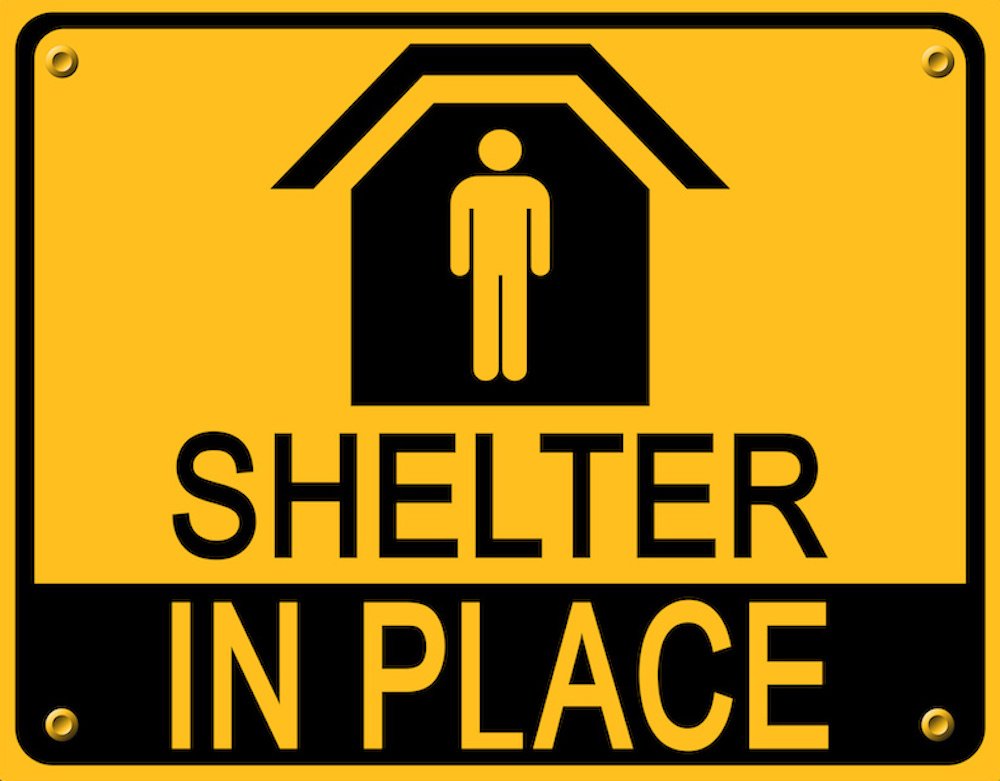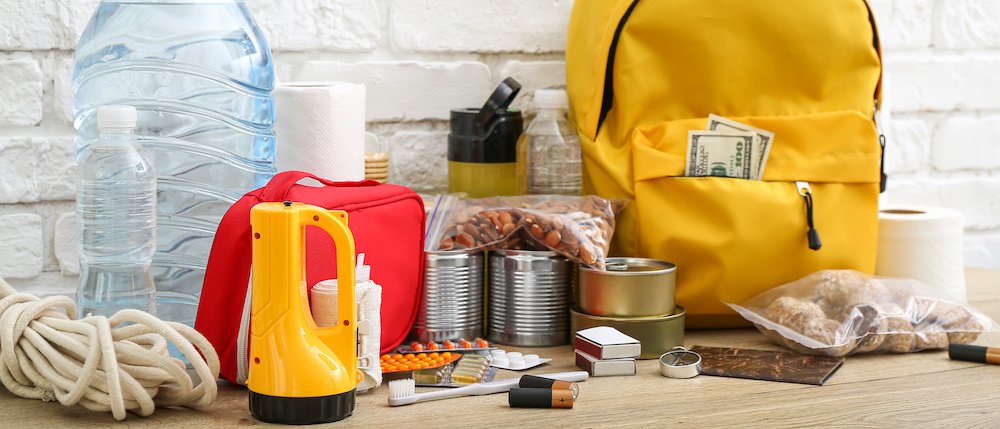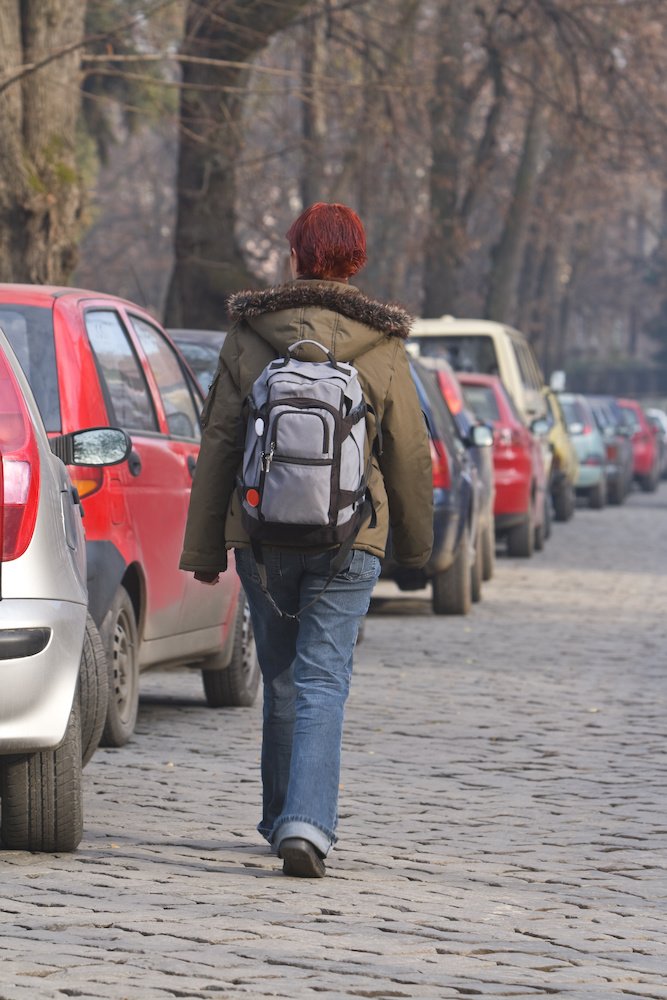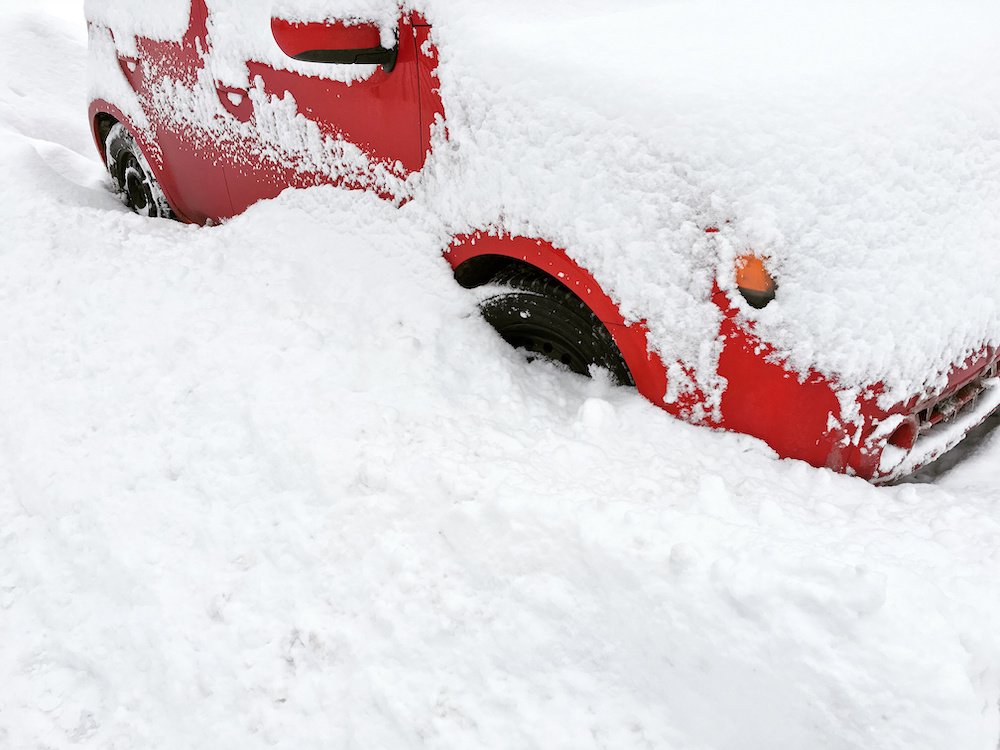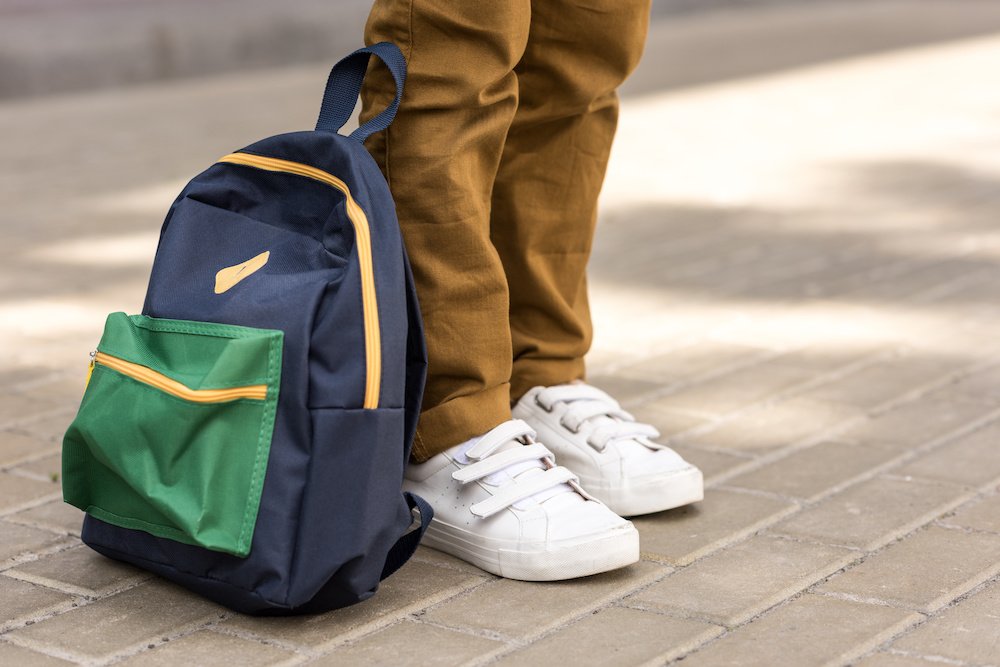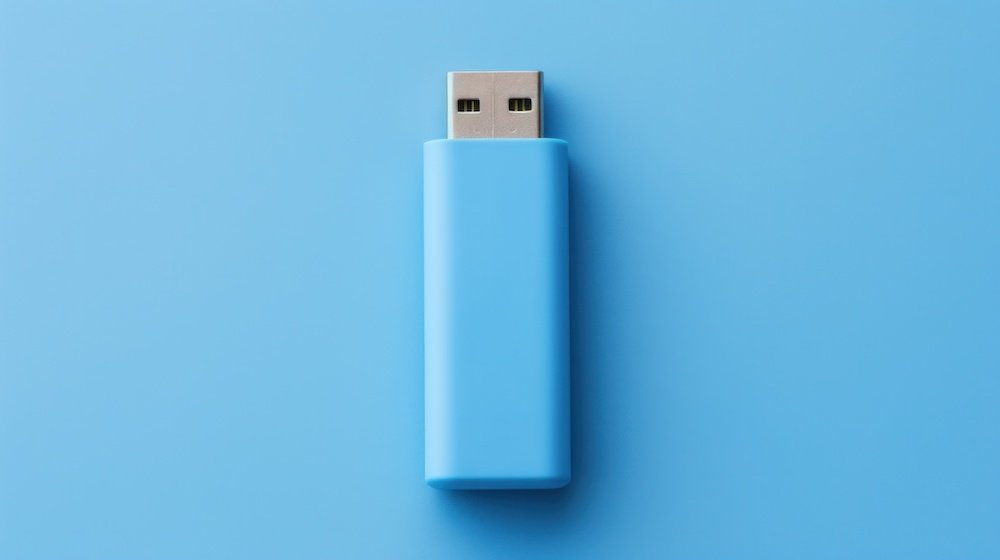Checklists for Emergency Gear/Supplies
Please use the embedded ecommerce links only after you’ve shopped for what you can from our local retailers. Take this list with you for local shopping.
Alternatively, you may find purchasing a readymade shelter-in-place kit to be easier and faster than building your own. We have a partnership with Cascadia Ready, which donates 5% of your purchase back to Bainbridge Prepares to further our community work.
Building your supply kits doesn’t have to cost a fortune. Be strategic about how you acquire items. Read our article about Getting Ready on a Budget for some ideas.
Some of these checklists were developed by our Founder and Board Chair Scott James, based on best practices gathered from FEMA, Red Cross, and preparedness organizations around the world. These lists—plus a Family Reunification Guide (here’s a custom version for the island residents)—are included as appendices in James’ book, Prepared Neighborhoods, which is available from Kitsap Regional Library, local booksellers, or Amazon. A portion of Scott’s royalties go to preparedness education. Other checklists were developed by our various teams.
Home Supplies
Your home supplies are the most important supplies you have. You use them to feed your go bags, school kits, vehicle kits, shelter-in-place kit, and get-home bags. Building your home supplies can take time. Even once you have what you need, you need to monitor the items for expiration.
Home Supplies Checklist
Food: You need food for at least three weeks. Make sure to have food for every member of the family, including pets and livestock.
Water: Store 1 gallon of water per person per day (including pets) and/or a way to filter and treat water.
Fire extinguisher: You need one on on each level of your home.
Emergency power: Consider a solar generator or a generator that you can charge up before an emergency.
Prescriptions/medical supplies: It is important to have backups of prescription meds. In an emergency, if you run out you will likely not be able to get a refill for a while.
Emergency cash: Small bills are better as you will likely have trouble getting change.
Under-the-bed supplies: Keep shoes, a hard hat, goggles, a flashlight, and gloves under your bed so, if an earthquake strikes when you are sleeping, you will be able to get out of bed safely.
Emergency communication plan and contact list: In an emergency, you won’t be able to think clearly and you don’t want to have to who digging through files or your desk.
Family reunification plan and meeting points: Everyone in your family needs to know the plan for different types of emergencies (earthquake, tornado, landslide, flood, snowstorm, wildfire, radiologic event, mass shooting).
Backup lighting: Have flashlights, lanterns, and headlamps with extra batteries stored outside the device (to avoid battery acid leaks).
Emergency toilet and sanitation supplies: If the power goes out or you have to evacuate, how will you stay clean and use the toilet? Stock hand sanitizer, toilet paper, kitty litter, 5-gallon buckets, and heavy trash bags.
Cooking equipment: In an emergency if the power goes out or you have to evacuate, how will you prepare food? Make sure to keep a barbecue grill or camp stove (for outdoor use only) and fuel. Do you have matches or a lighter?
Shelter: If you have to evacuate, how will you stay warm and protected from the elements? Keep a tent, emergency blankets, and/or sleeping bags in your supplies.
Tools: In an emergency you are likely to need a knife or multiuse tool, a can opener, a silcox key (for shutting off water and propane valves), and a hatchet.
First Aid Kit
We have two checklists in this section. One—the basic kit—is for people with little training. The other—the advanced kit—is for people who have taken First Aid, Wilderness First Aid, or Wilderness First Responder coursework.
You will want to have multiple first aid kits in different locations (at home, in your car, on your bike, etc.) for different purposes. Create each kit to fit the situation—for example, a bicycle kit should be small and light and mostly have gauze, tape, and alcohol-free wipes.
Note: Americans have been trained to use alcohol wipes or hydrogen peroxide to clean wounds and then to apply anibiotic ointment to the wound to prevent infection. However, recent research shows that these steps may actually be counterproductive. Hydrogen peroxide and alcohol kill healthy cells as well, so they may delay healing. Antibiotic ointment stays on the surface of a wound, potentially blocking the wound from draining. You are better off using Betadine, soap and water if possible, just warm water, or alcohol-free wipes.
First Aid Kit Checklists
Basic Kit
To treat pain and discomfort:
Acetaminophen (Tylenol)
Anti-diarrhea medication such as loperamide (Imodium) or bismuth subsalicylate (Pepto-Bismol or Kaopectate)
Anti-nausea medication such as bismuth subsalicylate (Pepto-Bismol or Kaopectate), dimenhydrinate (Dramamine), or meclizine (Bonine).
Aspirin (for cardiac events and blockages; aspirin can temporarily help thin the blood).
Diphenhydramine (an antihistamine like Benadryl) for use in treating mild allergic reactions
To stop bleeding:
Gauze pads
Maxipads (very absorbent) or cloth diapers
Hemostatic gauze (which helps blood clot) or Celox
Tourniquet (a CAT tourniquet is recommended)
An Israeli bandage (with an applicator to apply pressure
To treat shock:
· Emergency (mylar) blankets
To clean and protect wounds:
Betadine or alcohol-free wipes
Bandage tape
Gauze
Large adhesive pads
Adhesive bandages
To splint breaks or reduce swelling on sprains:
Elastic bandages
SAM splint (a moldable splint brand) or anything else that is semirigid and can be made to keep a fractured limb from moving. Cardboard can work well too.
Triangle bandages (or fabric cut and folded into a large triangle shape for a sling)
Advanced Kit
Breaks:
Elastic bandages
SAM splints/cardboard
Triangle bandages
Burns:
Burn gel
Stop the Bleed:
CAT tourniquet
Hemostatic gauze (which helps blood clot) or Celox
Gauze pads
Maxipads, tampons, or other absorbent materials
Gauze rolls and tape to hold the gauze in place.
An Israeli bandage
Medications:
Acetaminophen (Tylenol)
Anti-diarrhea medication such as loperamide (Imodium) or bismuth subsalicylate (Pepto-Bismol or Kaopectate)
Anti-nausea medication such as bismuth subsalicylate (Pepto-Bismol or Kaopectate), dimenhydrinate (Dramamine), or meclizine (Bonine).
Aspirin (for cardiac events and blockages; aspirin can temporarily help thin the blood).
Diphenhydramine (an antihistamine like Benadryl) for use in treating mild allergic reactions and to use in conjunction with epinephrine to treat anaphylaxis. Please note that EpiPens require a prescription, so you're not going to have one in your first aid kit. A person who needs an EpiPen will likely have one. Ask and then either get them to administer it or do it for them. Diphenhydramine is not adequate for treating anaphylaxis; it has been shown to support recovery from anaphylaxis only after the administration of epinephrine.
Wound Care:
Adhesive bandages in a variety of sizes
Betadine or alcohol-free wipes
Elastic bandages
Gauze pads and rolls
Large adhesive pads
Wound closure strips (Steri-Strips) and/or liquid stitches/surgical glue.
Tools & Equipment:
Blood pressure cuff. You have to learn how to use a blood pressure cuff and stethoscope properly to be able to take blood pressure. This is a challenging skill and can be made more challenging by loud noise; instead, you can buy an electronic cuff from your local drugstore. Although these don't give very precise readings, they can be useful for monitoring changes in blood pressure (like sudden spikes or drops).
CPR masks
Emergency mylar blankets
Non-latex gloves
Pulse oximeter (to take heart rate and oxygen levels)
Shears (to cut gauze and bandages)
Tweezers (to remove splinters and to pull gravel out of a road rash)
Stethoscope (to listen to the heart, lungs, and abdomen)
Syringe (to help irrigate a wound with water)
Thermometer (use a digital one for speed and because you can’t use an oral thermometer on unconscious people; bring extra batteries)
Sharpie (to record application time of tourniquet)
Pen and notebook (to track vitals and to record patient history and complaints)
Flashlight (to check eyes for concussion)
Goggles (to protect your eyes)
Shelter in Place
Sheltering in place is not something we have much reason to do in western Washington. But when we do, it is of utmost importance to do it right. Almost always, the occasion will be a chemical, biological, or radiological event.
Choose a safe room where you can stay closed in for several hours during such an event. Try to pick a room without too many windows that has an adjacent bathroom. Read more here about sheltering in place.
Shelter-in-Place Checklist
Plastic sheeting (precut to cover all windows, doors, outlets, and vents in your safe room)
Tape (to fix the sheeting in place)
Battery-powered radio
Water and snacks
A few towels/blankets (to moisten and stuff under doors in the safe room)
A flashlight
Go Bags
Your Go Bags are kept packed and ready at hand for a quick three-day evacuation out of the region. Since they are likely stored at your home, your Go Bags are part of your home kit. You do not need to duplicate gear purchases for both, but keep in mind the wisdom of redundancy when considering key items that could make life difficult if they were lost or broken without an available replacement (e.g., a can opener).
Add notes to this list for required items specific to you and your loved ones, such as medicines, assistive devices (e.g. eyeglasses), and regional-specific gear (e.g., a sun hat for desert dwellers, rain gear for folks in the Pacific Northwest). Also, consider any regional-specific natural disasters you may encounter and add related gear to your list (e.g., swim goggles and P100 breath masks if you’ll be sheltering-in-place after a volcanic eruption).
Each member of your household, including pets, should have a Go Bag. Balance loads for weight and content across all bags (i.e., don’t place 100 percent of the food in a single Go Bag). After you’ve assembled your Go Bag, take photos of each bag with its contents. Laminate these photos for easy reference later as to what is in each bag. Remember that your Go Bag contents are the same items in your Shelter-in-Place checklist. Store your Go Bags at your best point of egress; in a closet by the front door or near your vehicle.
Go Bag Checklist
Essentials
An amount of water that you can carry PLUS water purification method: purification tablets, small hand pumps.
Food: 3-day supply of non-perishable, nutrient-dense food for evacuation (include energy bars)
Battery-powered, solar, or hand-crank NOAA weather radio
Two flashlights (one handheld, one headlamp) with extra batteries stored outside of the flashlight
Small first aid kit, supplemented with Celox, trauma pads, athletic tape, Betadine, and disposable gloves
Medications (minimum 7-day supply)
Glasses, contact lenses with solution, hearing aids with backup batteries
Personal hygiene and comfort items: menstrual products, lip balm, pain relievers
Sanitation: toilet paper, hand sanitizer, moist towelettes, two trash bags, five large zippered bags, and plastic zip ties
Cell phone with chargers, battery backup, and/or solar charger
Sturdy shoes
Cell phone with chargers, battery backup, and/or solar charger
Complete change of sturdy clothing including a long-sleeved shirt, long pants
Two pairs of socks
Eye protection: sunglasses, safety goggles, and baseball cap
Weather protection: rain poncho or shell jacket, cold weather jacket if weather dictates
Sunscreen and bug spray if those are an issue in your bioregion
Regional map with possible evacuation routes marked
Important documents on a USB thumb drive.
Pet gear: sturdy leash, harness, collar with ID tags; collapsible water bowl; minimum 7-day supply of normal food and medications
Extras
Backpacking stove and cookset and utensils with fuel canisters
Sleeping bag or two Mylar blankets and duct tape to make your own emergency version bag
Tarp with 100’ paracord to secure it overhead or an one-person tent. Add a second ground tarp to stay dry.
Two-way radio (store batteries outside of the units)
Folding shovel
Saw
Compass
Highly visible reminder note to grab from your fireproof/waterproof safe extra keys to your house/vehicle and copies of important personal documents and cash (small bills)
Highly visible reminder note to retrieve items stored elsewhere (e.g., sleeping bags hung in a nearby closet)
Pet gear: crate for smaller animals not on voice control
Get-Home Bag
A Get-Home Bag is a version of your Go Bag stored at your workplace; its purpose is to assist you to get back home in an emergency when you don’t have access to your normal means of transportation. Store this backpack at your desk; do not assume you will have access to your vehicle or other areas of your workplace.
Get-Home Bag Checklist
Small/medium-sized backpack to hold items.
Water purification bottle, a Nalgene bottle with purification tablets, or a LifeStraw.
Food: lightweight, nutrient dense food such as energy bars.
Two-way radio (store batteries outside of the units themselves).
Two flashlights (one handheld, one headlamp) with extra batteries stored exterior to flashlight.
Small first aid kit, supplemented with Celox, trauma pads, athletic tape, Betadine, and disposable gloves.
Backup glasses, contact lenses with solution, hearing aids with batteries.
Personal hygiene and comfort items: menstrual products, lip balm, pain relievers.
Sanitation: toilet paper, hand sanitizer, moist towelettes, two trash bags, and five large Ziploc bags, and plastic zip ties.
Cell phone with chargers, battery backup, and/or solar charger.
Two Mylar blankets and duct tape to make your own emergency bag.
Sturdy shoes (leave your fancy work shoes at work).
Complete change of sturdy clothing including a long-sleeved shirt and long pants.
Two pairs of socks.
Eye protection: sunglasses, safety goggles, and hat.
Weather protection: rain poncho or shell jacket, cold weather jacket.
Regional map with possible “get home” routes marked.
Important documents on a USB thumb drive.
Vehicle Bag
Your vehicle bag keeps supplies you might need during an emergency that occurs while you are on the road. Imagine being caught in a snowstorm, a major pileup on a highway, or a long line of slowly-moving evacuation traffic. In 2022, people in Virginia were stuck on a snowbound highway for 24 hours.
Update supplies according to the season. Always keep your tank at least half full (or your electric car battery at least half charged).
Vehicle Bag Checklist
Year ‘round:
Food
Water
Phone chargers
Flashlight
Emergency radio and batteries
First aid kit
Jumper cables
Seatbelt cutter/window breaker tool
Foldable, reflective warning triangle
Small, foldable shovel
In winter, add the following:
Tire chains
Snow and ice scraper
Emergency blankets
Hat and gloves
Cat litter, sand, or carpet remnants (for tire traction)
Bike safety flag (that you can zip tie to your roof rack or antenna in a snow storm to help people find you)
Zip ties
Children's Emergency Kit for School
At the start of each school year, pack a small emergency kit for your child to keep in their backpack or at their desk. Try to pack most items in a quart-size zip bag or pouch.
Children’s Emergency Kit for School Checklist
Water (emergency water pouches)
Protein snacks or granola bars (be mindful of food allergies)
Small first aid kit
Emergency blanket
Small flashlight
Surgical Mask/KN95/N95
Extra health-related items your child uses
Hard candies for comfort & energy
Comfort item (small stuffed animal or toy)
Chapstick and antibacterial hand sanitizer
Wipes
Family reunification card (with contact info) and family photo (this helps with family identification and reunification)
Emergency Documents
Keep digital copies of your emergency documents on USB keys or thumb drives. Add the keys to your go bags and .get-home bags.
Emergency Document Checklist
Personal Documents
Birth Certificates
Driver’s License
Military records
Social Security Cards
Passports
Immunization Records
Religious Certificates / Blessings
Diplomas
Tax and Investment Documents
Years Income tax returns
Property Tax Statements
Investment plan summaries
Stock Certificates
Bonds
Certificates of Deposit
Legal Agreements
Marriage certificates
Divorce records
Prenuptial/postnuptial
Other contracts
Legal Documents
Prenuptial / postnuptial
Child custody agreements
Utility bill as proof of residency
Adoption Papers
Death Certificates
Testamentary Documents
Will
Trust and amendments
Contract info. for everyone named in will/trust
Living will
Power of attorney
Property
Deeds
Titles
Appraisals
Home inventory list/digital photos
Insurance
Policy summary pages
ID cards
Vehicle registration cards
Other
Recent and old family photos (including photos of pets)
Cash (small bills)
Maps of area
